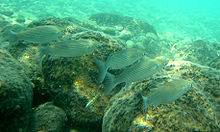Mullet (fish)
| Mullet | |
|---|---|

| |
Mugil cephalus
| |
| Scientific classification | |
| Domain: | Eukaryota |
| Kingdom: | Animalia |
| Phylum: | Chordata |
| Class: | Actinopterygii |
| (unranked): | Acanthomorpha |
| Superorder: | Acanthopterygii |
| Clade: | Percomorpha |
| (unranked): | Ovalentaria |
| Order: | Mugiliformes |
| Family: | Mugilidae Jarocki, 1822 |
| Type species | |
Mugil cephalus
, 1758 | |
| Genera | |
|
See text. | |
The mullets or grey mullets are a
Mullets are distinguished by the presence of two separate dorsal fins, small triangular mouths, and the absence of a lateral line organ. They feed on detritus, and most species have unusually muscular stomachs and a complex pharynx to help in digestion.[1]
Classification and naming


In North America, "mullet" by itself usually refers to Mugilidae. In Europe, the word "mullet" is usually qualified, the "grey mullets" being Mugilidae and the "red mullets" or "surmullets" being Mullidae, notably members of the genus Mullus.[7] Outside Europe, the Mullidae are often called "goatfish".[8] Fish with common names including the word "mullet" may be a member of one family or the other, or even unrelated such as the freshwater white sucker (Catostomus commersonii).[9]
However, recent taxonomic work has reorganised the family and the following genera make up the Mugilidae:[10][11]
- Agonostomus Bennett, 1832
- Aldrichetta Whitley, 1945
- Cestraeus Valenciennes, 1836
- Gill, 1863
- Chelon Artedi, 1763
- Crenimugil Schultz, 1946
- DajausValenciennes, 1836
- EllochelonWhitley, 1930
- Gracilimugil Whitley, 1941
- Joturus Poey, 1860
- , 2012
- Linnaeus, 1758
- Myxus Günther, 1861
- Neomyxus Steindachner, 1878
- Neochelon Durand, Chen, Shen, Fu & Borsa 2012
- Oedalechilus Fowler1903
- Osteomugil G. Luther, 1982
- Parachelon Durand, Chen, Shen, Fu & Borsa 2012
- Paramugil Ghasemzadeh, Ivantsoff & Aarn 2004
- Planiliza Whitley, 1945
- PlicomugilSchultz, 1953
- Pseudomyxus Durand, Chen, Shen, Fu & Borsa 2012
- RhinomugilGill, 1863
- SicamugilFowler, 1939
- Squalomugil Ogilby, 1908
- TrachystomaOgilby, 1888
Behaviour
A common noticeable behaviour in mullet is the tendency to leap out of the water. There are two distinguishable types of leaps: a straight, clean slice out of the water to escape predators and a slower, lower jump while turning to its side that results in a larger, more distinguishable, splash. The reasons for this lower jump are disputed, but have been hypothesised to be in order to gain oxygen rich air for gas exchange in a small organ above the pharynx.[12]
Development
The
Timeline

References
- ^ ISBN 978-0-12-547665-2.
- Fishbase. Retrieved 25 March 2017.
- ^ "Fishes of the World, 4th Edition". Wiley. Archived from the original on 2012-03-18. Retrieved 2012-04-12.
- ^ Gosline, W. A. (1961) "The Perciform Caudal Skeleton" Copeia 1961(3): pp. 265–270
- ISBN 9780521229265.
- ISBN 978-1-118-34233-6. Archived from the originalon 2019-04-08. Retrieved 2018-10-25.
- ^ "Mullet species". britishseafishing.co.uk. 14 September 2012. Retrieved 25 March 2017.
- ^ "Goatfish". Encyclopædia Britannica. Retrieved 25 March 2017.
- Fishbase. Retrieved 25 March 2017.
- PMID 23199637.
- ^ Froese, Rainer, and Daniel Pauly, eds. (2021). "Mugilidae" in FishBase. February 2021 version.
- S2CID 35924254.
- ^ .
Further references
- J.S. Nelson, ISBN 978-0-471-25031-9.
- Froese, Rainer, and Daniel Pauly, eds. (2012). "Mugilidae" in FishBase. June 2012 version.
- Sepkoski, Jack (2002). "A compendium of fossil marine animal genera". Bulletins of American Paleontology. 364: 560. Retrieved 2011-05-19.
- Eschmeyer, William N.; Fricke, Ron & van der Laan, Richard (eds.). "Genera in the family Mugilidae". Catalog of Fishes. California Academy of Sciences. Retrieved 25 September 2020.
